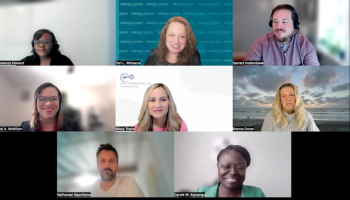
New Clues into How Invasive Parasite Spreads
Researchers at Albert Einstein College of Medicine of Yeshiva University have discovered a possible strategy against an invasive parasite that infects more than a quarter of the world’s population, including 50 million Americans.
The study, involving the single-celled parasite Toxoplasma gondii, was led by Amos Orlofsky, PhD, assistant professor of pathology at Einstein. The results, published in the current issue of the Journal of Immunology, suggest a new approach for treating toxoplasmosis, the disease caused by this parasite.
T. gondii is one of the great success stories of the parasite world, capable of infecting any warm-blooded animal. Infected people carry thousands of organisms, many of which reside in the brain. Most people infected with T. gondii have an inactive, or latent, infection that causes no symptoms. But T. gondii can cause serious brain damage in patients with HIV/AIDS, the elderly, fetuses, and others who have weakened or developing immune systems.
“Toxoplasmosis can be treated with antimalarial drugs and antibiotics, but these medications can have serious side effects, so there is much interest in finding better therapies,” says Orlofsky.
People become infected by ingesting T. gondii oocysts (the thick-walled spore phase of the parasite found in the feces of infected cats) or by eating undercooked pork or other infected meat. Once the parasite is swallowed, its tachyzoites (the form of the parasite that causes disease in humans) multiply by infecting cells and then reproducing several times within each cell. Finally, the parasitic cargo ruptures its host cell and exits to infect new cells.
In prior research, petri dish studies had suggested that tachyzoites progress through five to seven cell-division cycles over a leisurely two to three days before rupturing the host cell and initiating a new round of infection. But in a key finding, the Einstein team discovered that in real life (infected mice in this case), the multiplication cycle goes much faster: After infecting macrophages—the immune cells that are among their favorite targets—infecting parasites rupture the cells in about six hours after undergoing only one or two cell-division cycles.
In a second major finding, the Einstein team discovered a clue to why parasites burst from their macrophage hosts after just one or two rounds of reproduction: Macrophages rushing to the infection site somehow signal to their infected brethren in a way that stimulates parasites to abandon ship. The researchers suspect that this reaction reflects a shift in the stance of the host cell from passivity to hostility with respect to the parasites within. “Sensing that their host cell is in attack mode, the parasites may respond by taking an early exit,” says Orlofsky.
The scientists don’t yet know the mechanism by which immune cells trigger the parasites’ early exit from infected cells. But drugs with this mode of action might help to curb or even eliminate toxoplasmosis by encouraging infected cells to combat their parasites. Such drugs might work well in combination with treatments that block the parasites’ escape route. “If we can make the parasites want to leave, but stop them from doing so, that could be the basis of an effective therapy,” says Orlofsky.
Orlofsky’s paper, “Externally Triggered Egress Is the Major Fate of Toxoplasma gondii during Acute Infection,” was published October 21 in the online edition of the Journal of Immunology. Tadakimi Tomita, a PhD student at Einstein, is the lead author. The other Einstein contributors were Tatsuya Yamada, also a PhD student, and Louis M. Weiss, MD, MPH, a professor of medicine and of pathology.
Newsletter
Stay prepared and protected with Infection Control Today's newsletter, delivering essential updates, best practices, and expert insights for infection preventionists.






